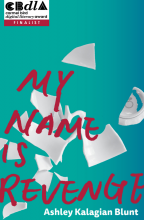Back in pre-computer days when the History taught in our schools seemed to be fixated on Medieval England to the exclusion of everywhere and everything else (including Aboriginal history which has always pissed me off in the extreme), we, unsurprisingly given the myopic focus, never explored events surrounding either of the World Wars. Since then my forays into education in this sphere have been shamfully sporadic so I'm grateful for this novella and essay which is casting some light into this corner.
From the Blurb:
My Name Is Revenge is in two parts. There is a novella, and an essay reflecting on the historic events that inspired that novella, and meditating also on how history can inform fiction. In the essay the writer says she hopes everything she writes will ‘arouse curiosity’. Both the novella and the essay do just that, and also much, much more. Both pieces are informed by a passion to express the haunting of almost unimaginable historical crimes, and the tragic shapes that vengeance for those crimes can take.
“The novella is a powerful exploration of the long-term, far-flung effects of the horrors of the genocide of the Armenian people by the Ottoman government during World War One. The narrative is set in Sydney in 1980, and it dramatizes the assassination of the Turkish Consul by the grandsons of a victim of the 1914 genocide. The author’s grandfather saw ‘his entire family killed while he hid in the upper branches of a tree’.
“The essay is a compelling account of how the author, great-grand-child of victims of the genocide, has worked with the bitter historical events which began on the day before the landing of the Australian troops at Gallipoli. This planned co-incidence of horrors affords the whole manuscript an urgency for Australian readers in particular. To quote from the text, this is ‘an echo of terror across six decades’. And ‘revenge’ is the very meaning of the main character’s name.
My Name Is Revenge is in two parts. There is a novella, and an essay reflecting on the historic events that inspired that novella, and meditating also on how history can inform fiction. In the essay the writer says she hopes everything she writes will ‘arouse curiosity’. Both the novella and the essay do just that, and also much, much more. Both pieces are informed by a passion to express the haunting of almost unimaginable historical crimes, and the tragic shapes that vengeance for those crimes can take.
“The novella is a powerful exploration of the long-term, far-flung effects of the horrors of the genocide of the Armenian people by the Ottoman government during World War One. The narrative is set in Sydney in 1980, and it dramatizes the assassination of the Turkish Consul by the grandsons of a victim of the 1914 genocide. The author’s grandfather saw ‘his entire family killed while he hid in the upper branches of a tree’.
“The essay is a compelling account of how the author, great-grand-child of victims of the genocide, has worked with the bitter historical events which began on the day before the landing of the Australian troops at Gallipoli. This planned co-incidence of horrors affords the whole manuscript an urgency for Australian readers in particular. To quote from the text, this is ‘an echo of terror across six decades’. And ‘revenge’ is the very meaning of the main character’s name.

